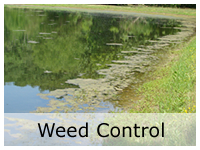Lime is added to ponds to increase the water’s alkalinity, usually so a fertilizing program can begin. Not all lakes need lime so your lake’s water needs to be tested to determine if it needs lime. The alkalinity of the water should be above 20 mg/l for fertilization to be effective. There are a number of different materials that can be used to lime ponds. The most commonly used material is agricultural limestone. It can be either calcitic limestone (CaCO3) or dolomitic limestone (CaMg(CO3)2 - preferred). Additions of limestone will help your pond maintain a more constant pH. The overall pH of your pond will be higher (and more suitable for the fish), and the daily pH fluctuations will be less (the limestone acts as a buffer). The higher pH increases available phosphorous, so the nutrients that are locked up in the pond bottom soils will be freed to increase the productivity of the pond. Dolomitic limestone contains Calcium and Magnesium, both important plant nutrients, and the calcium is necessary for crustaceans that inhabit your ponds. Limestone aids in the decomposition of organic materials such as leaves and reduces accumulation on the pond bottoms. Lime also helps settle clay particles in ponds that have muddy water. The water quality produced through liming sustains healthy phytoplankton populations, which helps cycle nutrients and wastes more efficiently. Lime increases the amount of natural foods available to your fish. Lime is applied at 2-6 tons per surface acre. It is important to cover as much of the pond bottom as possible and an application can last 3 or 4 years.
We have the lime delivered to a suitable area of your pond and spread it evenly over the entire bottom of the pond with our special lime barge. We need a front end loader or tractor to put it on the boat. We can usually apply 80-100 tons in a day. We have a 20 ton mimimum.
Other liming materials:
Two other common liming materials are calcium hydroxide (a.k.a. hydrated lime, slaked lime or builder’s lime - Ca(OH)2) and calcium oxide (a.k.a. quick lime, unslaked lime or burnt lime - CaO). These materials can be toxic to fish and insects. The application methods and rates of these materials is quite different than those for agricultural limestone. They are commonly used to produce temporary alkalinity or used to sterilize pond bottoms.


